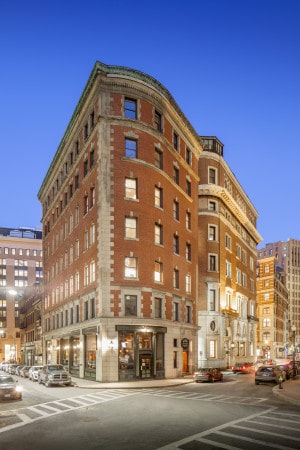
The availability rate at class B office buildings in Boston has hit an eight-year low while rents are up 10.5 percent in the past year. Atlas Real Estate Partners of New York paid $12.25 million in June for 4 Liberty Square, a 26,000-square-foot office and retail building in the Financial District that previously sold for $8.8 million in 2014.
Multifamily properties in the northern suburbs, class B office buildings in Boston and industrial conversions in the inner-ring communities could attract strong interest from investors in 2017, commercial real estate brokers and analysts predict.
Nearly a decade since the market’s last trough, opportunities for value-oriented real estate investments would appear increasingly scarce. At the same time, Greater Boston’s continuing economic growth and demand for urban workspaces and housing will continue to benefit Boston and Cambridge leasing and investment sales in 2017, industry experts predict.
“The fundamentals are strong across the board here in Boston, and we’ve certainly seen the most aggressive growth in the class B (office) market,” said Frank Petz, managing director of JLL’s capital markets team in Boston. “Class A appears to be poised for some growth this year as the outlook for financial services improves.”
Companies in the TAMI (technology, advertising, media and information technology) sector that favor brick-and-beam buildings over towers have driven class B availabilities down to 13.1 percent, the lowest level since 2008, according to Transwestern research.
Asking rents for class B space have risen 10.5 percent in the past year to $41.31 per square foot, just $13.79 below the going rate for class A space. That’s a far cry from 2008, when class A rents commanded a $31.51 per square foot premium, said Chase Bourdelaise, director of research for Transwestern in Boston.
Class B office buildings in Boston are attracting some of the largest buyer pools because of their potential to be renovated as open-format office space, said Doug Jacoby, executive vice president for Colliers International’s investment sales team in Boston. Properties in the $50 million and under range remain popular investments among high-net worth and family office investors from Asia and Europe, he said.
Even with record-breaking prices set in 2015 and 2016 for some trophy office towers, institutional investors continue to favor office properties inside Route 128, particularly downtown Boston and Cambridge, Jacoby said.
“They’ve seen what’s happened for 15 years: the (suburban) rents haven’t grown much and the demand for the suburbs (from office tenants) hasn’t been there,” he said.
JLL’s Petz said foreign capital is starting to show interest in “best-in-class” office properties in core suburban markets, such as central Route 128.
Multifamily Rent Growth In Suburban Markets
The busy development pipeline has turned multifamily investment sales into a multi-billion-dollar annual business, with total transaction volume expected to top $2 billion for the second consecutive year.
“There are a lot of merchant builders out there whose business model is to build, lease up and sell, and we’ll continue to see that in 2017 with a lot of supply that’s being delivered,” said Travis D’Amato, managing director for JLL’s multifamily investment sales team. “We’re in this `New Normal’ for (Greater) Boston for multifamily where it’s now a $2-3 billion volume business.”
Job and population gains continue to favor multifamily rent growth in 2017, D’Amato said.
Chris Sower, a senior vice president with Colliers International in Boston, said institutional investors are moving down into the middle-market space for value-add opportunities. That’s also the niche that would be most sensitive to interest rate increases, Sower said.
“Just because it’ll be more expensive on the interest rate side doesn’t mean (buyers) will go away from that space. They’ll fund more from an equity perspective or there will be an impact on pricing,” he said.
The impact of Boston’s luxury apartment construction boom already has been felt in flattening rents for new luxury properties. But some opportunities for rent growth remain in suburban regions.
The North Shore/Merrimack Valley led all Boston submarkets with 5.1 percent rent growth in the 12 months ending November 2016, according to multifamily researchers Axiometrics. That compares with just 0.8 percent in the city of Boston.
“In pockets where we’ve seen a lot of (development) we’ll see stagnant rent growth, but we’re not seeing drops in occupancy,” D’Amato said. “Anyplace where you’re at a discount from the top of the market and have access to MBTA lines in well-located suburbs, you’re going to see opportunities for good rent growth.”
Colliers’ Sower said multifamily investors are showing continuing interest in acquiring industrial properties in suburbs such as Chelsea, Revere and Somerville for in-fill development.
Unlike the local office market, international buyers haven’t been a major factor in multifamily investment sales in recent years. The major exception is Swedish real estate company Akelius US, which has acquired more than $1 billion in U.S. multifamily properties since 2015 including five portfolios in Greater Boston. But others could take a page from Akelius’ strategy, Sower said.
“We’re getting meetings on a weekly basis with international investors that are coming here,” he said. “With the new presidency, we’re considered more attractive internationally and people believe the economy is going to be that much stronger. They’re not concerned with where the capital or debt markets are. Typically they’re low leverage and looking at (Greater) Boston as a place of secure investment.”




 |
| 


